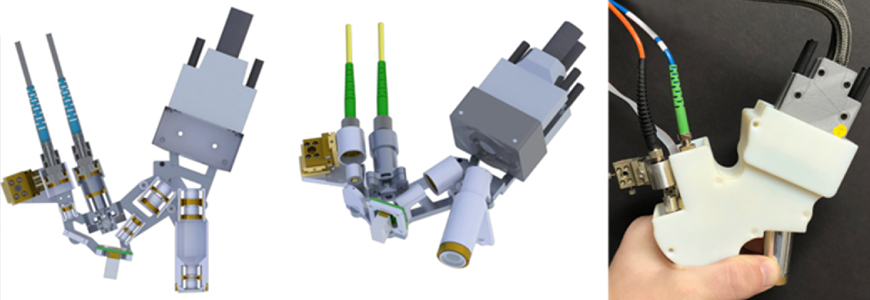Duke researchers have developed the first handheld probe with resolution-enhancing adaptive optics technology capable of imaging individual photoreceptors in vivo. The technology, a handheld adaptive optics scanning laser ophthalmoscopy (HAOSLO) system, has the potential to improve the diagnosis and prognosis of retinal diseases in new patient populations such as infants.
At present, AOSLO is the most common imaging system for the in vivo visualization of individual photoreceptors in adults. However, such systems are large and costly, and their use is limited to patients who are able to sit upright and fixate for several minutes. AOSLO is therefore not useful for young children or adults with cognitive or mobility issues.
To develop a high-resolution, portable system that could be used in these populations, Duke researchers modified the traditional AOSLO system’s optical and mechanical design as well as its signal processing system. This included developing a new algorithm that replaces AOSLO’s large wavefront sensing system. Notably, unlike previous algorithms, the new algorithm allows for dynamic correction, making it suitable for use with a handheld device. The modified system measures just 4 inches by 2 inches by 5.5 inches and weighs less than half a pound.
To assess the HAOSLO system’s clinical potential, the researchers imaged the retina of 12 adults and two children. They found that the new device could rapidly and reliably capture detailed images of photoreceptors close to the fovea in supine subjects. The results were published in Optica in August 2018.
“Our new tool is fast and lightweight, so physicians can take it directly to their patients,” says Sina Farsiu, PhD, an associate professor in the departments of biomedical engineering and ophthalmology. “And the probe allows us to collect images quickly, even if there is movement. These capabilities allow us to open up the pool of patients who could benefit from this technology.”
The team, which also includes Duke professors Joseph Izatt, PhD, and Cynthia Toth, MD, is optimistic about the tool’s use both inside and outside the hospital. Because HAOSLO can be taken into an operating room, physicians will be able to see the photoreceptors at the highest resolution possible during surgery, even when a patient is under anesthesia and in a reclined position. It could also help doctors track early brain development via retinal imaging or rapidly assess possible brain trauma in athletes.
Before the researchers prepare for large-scale clinical trials, they plan to incorporate additional imaging modes for detecting other diseases.
They also have made the mechanical designs, computational algorithms and control software freely available online so that other scientists can adapt the new system for their scientific applications. (http://people.duke.edu/~sf59/HAOSLO.htm).
